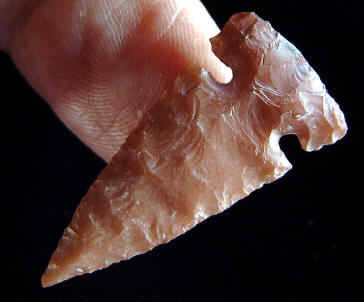|
SIDE-NOTCHED POINT This Anasazi side-notched arrow point dates to the Pueblo III Period between A.D. 1100 and A.D. 1300. It was discovered during excavation of the Wallace Ruin site near Cortez, Colorado. This side-notched point was made from a beautiful piece of red Jasper and it measures 1 5/16 inches (3.3 cm) long. ANASAZI ERA by Bruce Bradley, PhD. On the Colorado Plateau of northeastern Arizona, southwestern New Mexico, southeastern Utah and southwestern Colorado the Archaic was followed by a culture termed the Anasazi. This was a generalized village dwelling group which relied primarily on the cultivation of corn, beans and squash. Hunting did remain as part of the food gathering process throughout the Anasazi era. There is growing evidence that warfare may also have played a small role in Anasazi society. The Anasazi era has been separated into two major divisions: (1) the Basketmaker, and (2) the Pueblo. Each of these is further subdivided into social organizations. The Anasazi era is usually considered to fall between A.D. 1 and A.D. 1300. This time was followed by further development of a pueblo dwelling culture which is still existing today in New Mexico and Arizona. |
|
"REFERENCES" Personal communication with Dr. Bruce Bradley. |
